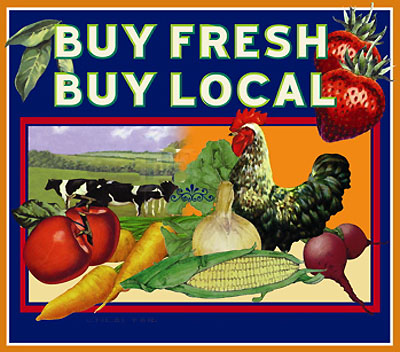By
Paul Adams on 21 November 2006 in Wired
Magazine
The first thing I did when my friends invited me to their seasonal
potluck was pull out a map and a sharp compass.
My friends, Jessica Abel and Matt Madden, are exemplary hosts,
and the potlucks they've thrown once a season are pretty casual
affairs with just one constraint: Every ingredient of every dish
must have been grown and processed within a 100-mile radius of
their house in Brooklyn, New York.
That means not just no flour or oil, but no beer (plenty's brewed
locally, but the barley and hops come from outside the radius),
no cinnamon and no coffee.
I wanted to bring my favorite apple-buttermilk cobbler, but sugar
was well outside the boundaries. Maple syrup might make a good
substitute, but I couldn't find any in a week's hunting. Finally
I abandoned the dessert idea and decided to go with a nice, hearty
beef stew.
Hundreds of "locavores" scattered around the country
are celebrating Thanksgiving this year with their own 100-mile
meals.
Local, sustainable eating is a noble cause. As advocates like
Alice Waters and Michael Pollan have labored to make clear, it's
good for both eater and eaten, not to mention the economy and
the planet. The 100-mile diet is perhaps the quickest and cleverest
way to build awareness of food miles, and the pleasures and challenges
of local "foodsheds." In just one traditional Thanksgiving
dessert, easily assembled at any supermarket, pecans from Georgia
fill a pie shell made with Oregon wheat and Wisconsin butter,
with corn syrup from Iowa, sugar from Florida, bourbon from Kentucky.
If you're eating it in New York, that adds up to some 6,000 miles
for one pie -- 14,000 if you splash in some Madagascar vanilla.
The idea was popularized by Gary Paul Nabhan in his 2001 book,
Coming Home to Eat, a description of his yearlong project to eat
nothing from outside a 250-mile radius of his Arizona home. In
his book, Nabhan waxes perfervid about the joys of wolfberry salad
and rattlesnake fritters.
Other locavores, like Alisa Smith and James MacKinnon, have tightened
the radius and softened the rhetoric: As documented on 100-Mile
Diet and in their forthcoming book, the couple ate within 100
miles of their Vancouver, British Columbia, home for a year starting
in March 2005, and remain active advocates of local eating. A
San Francisco Bay Area group put together an "Eat Local Challenge"
in August 2005, and the blog they started has become a community
and clearinghouse for local-minded eaters around North America.
Personally, I find local products more eye-openingly delicious
than their factory-farmed counterparts, but 100-mile cooking appeals
most to the puzzle-solver in me. Improvising a meal under such
tight strictures reminds me of the constrained literary projects
of Oulipo, under whose auspices, for instance, Georges Perec wrote
his novel La Disparition without the letter "e." My
host Matt, by no coincidence, has a similar bent: His 2005 book,
Exercises in Style, tells the same comic-strip story in 99 different
styles.
In the same way, 100-mile cooks are forced to come up with creative
solutions to the hurdles they encounter. With nutmeg and allspice
forbidden, ethnobotanist Leda Meredith spices her pumpkin puree
with spicebush berries and peppergrass seeds; MacKinnon replaces
coconut with taste-alike green hazelnuts, and sprinkles dried
kelp in place of salt.
I usually flavor my beef stew with a magical triad of wine, beer
and coffee, but beer and coffee were off-limits, so I had to substitute
a thinner New York state wine for the hearty Californians I prefer.
I would ordinarily dredge the beef in flour before browning it,
and add prunes at the beginning and mustard at the end, but all
of that went by the board. Nonetheless, with local pasture-fed
beef, carrots, potatoes, parsnips, turnips and pearl onions, the
stew turned out to be a hit.
Matt mixed cocktails with pear brandy, Jessica cooked a soufflé
and a buttery potato galette and Bryan capped off the dinner with
a pear-chestnut ravioli dessert.
With the ground frozen, winter's meal is going to be tougher,
but I embrace the noble challenge. I'm already planning a February
fishing trip.
|
